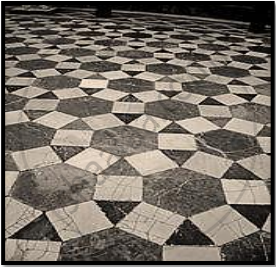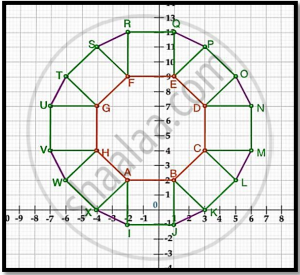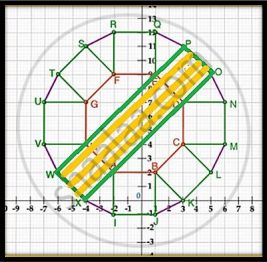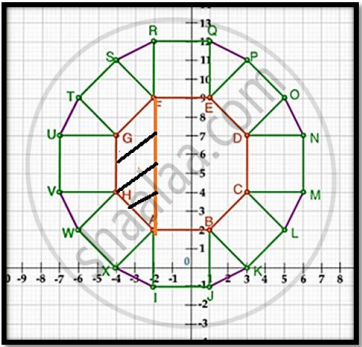Advertisements
Advertisements
प्रश्न
A tiling or tessellation of a flat surface is the covering of a plane using one or more geometric shapes, called tiles, with no overlaps and no gaps. Historically, tessellations were used in ancient Rome and in Islamic art. You may find tessellation patterns on floors, walls, paintings etc. Shown below is a tiled floor in the archaeological Museum of Seville, made using squares, triangles and hexagons.

A craftsman thought of making a floor pattern after being inspired by the above design. To ensure accuracy in his work, he made the pattern on the Cartesian plane. He used regular octagons, squares and triangles for his floor tessellation pattern

Use the above figure to answer the questions that follow:
- What is the length of the line segment joining points B and F?
- The centre ‘Z’ of the figure will be the point of intersection of the diagonals of quadrilateral WXOP. Then what are the coordinates of Z?
- What are the coordinates of the point on y-axis equidistant from A and G?
OR
What is the area of Trapezium AFGH?
उत्तर
i. B(1, 2), F(–2,9)
BF2 = (–2 –1)2 + (9 – 2)2
= (–3)2 + (7)2
= 9 + 49
= 58
So, BF = `sqrt(58)` units
ii.

W(–6, 2), X(–4, 0), O(5, 9), P(3, 11)
Clearly, WXOP is a rectangle
The point of intersection of the diagonals of a rectangle is the midpoint of the diagonals. So the required point is the mid point of WO or XP.
= `((-6 + 5)/2, (2 + 9)/2)`
= `((-1)/2, 11/2)`
iii. A(–2, 2), G(–4, 7)
Let the point on y-axis be Z(0, y)
AZ2 = GZ2
(0 + 2)2 + (y – 2)2 = (0 + 4)2 + (y – 7)2
( 2)2 + y2 + 4 – 4y = (4)2 + y2 + 49 – 14y
8 – 4y = 65 – 14y
10y = 57
So, y = 5.7
i.e. the required point is (0, 5.7)
OR

A(–2, 2), F(–2, 9), G(–4, 7), H(–4, 4)
Clearly GH = 7 – 4 = 3 units
AF = 9 – 2 = 7 units
So, height of the trapezium AFGH = 2 units
So, area of AFGH = `1/2`(AF + GH) × height
= `1/2`(7 + 3) × 2
= 10 sq.units
APPEARS IN
संबंधित प्रश्न
Find the distance between the following pair of points:
(a, 0) and (0, b)
Which point on the x-axis is equidistant from (5, 9) and (−4, 6)?
Find the third vertex of a triangle, if two of its vertices are at (−3, 1) and (0, −2) and the centroid is at the origin.
Find the points on the y-axis which is equidistant form the points A(6,5) and B(- 4,3)
Find the co-ordinates of the point which divides the join of A(-5, 11) and B(4,-7) in the ratio 7 : 2
In what ratio does the point P(2,5) divide the join of A (8,2) and B(-6, 9)?
Find the area of the triangle formed by joining the midpoints of the sides of the triangle whose vertices are A(2,1) B(4,3) and C(2,5)
Find the coordinates of the points of trisection of the line segment joining the points (3, –2) and (–3, –4) ?
ΔXYZ ∼ ΔPYR; In ΔXYZ, ∠Y = 60o, XY = 4.5 cm, YZ = 5.1 cm and XYPY =` 4/7` Construct ΔXYZ and ΔPYR.
If the point \[C \left( - 1, 2 \right)\] divides internally the line segment joining the points A (2, 5) and B( x, y ) in the ratio 3 : 4 , find the value of x2 + y2 .
What is the distance between the points (5 sin 60°, 0) and (0, 5 sin 30°)?
The distance between the points (cos θ, 0) and (sin θ − cos θ) is
If (x , 2), (−3, −4) and (7, −5) are collinear, then x =
If the centroid of the triangle formed by (7, x) (y, −6) and (9, 10) is at (6, 3), then (x, y) =
The line 3x + y – 9 = 0 divides the line joining the points (1, 3) and (2, 7) internally in the ratio ______.
Point (–3, 5) lies in the ______.
If the perpendicular distance of a point P from the x-axis is 5 units and the foot of the perpendicular lies on the negative direction of x-axis, then the point P has ______.
If the coordinates of the two points are P(–2, 3) and Q(–3, 5), then (abscissa of P) – (abscissa of Q) is ______.
If the coordinate of point A on the number line is –1 and that of point B is 6, then find d(A, B).
The distance of the point (–6, 8) from x-axis is ______.
